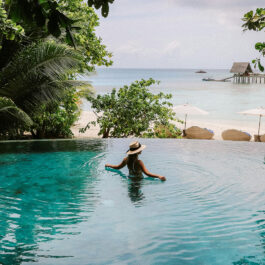On my first day in Ljubljana, I meandered through the Old Town’s riverside streets and cobbled lanes, ticking off guidebook recommendations including the city’s iconic hilltop castle. Slovenia’s capital has beauty to rival any great European city, but after an afternoon of standard sightseeing, I was itching to discover more.
The next day, determined to dig deeper, I decided to take the advice of my Uber driver who had picked me up at the train station: “Slovenians are shy,” he said. “There are plenty of people doing cool, creative things, but they’re not loud about it. You’ll have to knock on a few doors.”
It was the nudge I needed to leave the guidebook behind and uncover a different side of the Slovenian capital. It turned out to be easier than I anticipated.

[Image by Blaz Pogacar]
Venturing beyond the main tourist hub, I spotted a group of hip twenty-somethings gathered around a three-story concrete building on the banks of the Ljubljanica River. Apart from the smattering of picnic tables, around which creative types smoked and drank third-wave coffee, there was no indication that I had just stumbled upon one of the most important cultural hubs in Europe: Center Rog, Europe’s largest maker space, which debuted inside a former Yugoslav-era bicycle factory last fall.
No knocking required – I walked straight through the door, approached the reception, and asked for a tour. Within minutes, I was exploring the expansive complex with director-general Renata Zamida, who led me through airy artist studios and a series of “production labs,” where instructors guided aspiring creators in a range of disciplines. For just 15 euros a year, members have the freedom to drop in anytime to try their hand at everything from jewellery design and 3D printing to goldsmithing, pottery and experimenting with innovative biomaterials like vegan leather, wood-ash “concrete” and natural dyes derived from avocado pits.
Renata proudly explained that Center Rog fills a critical gap in Slovenia’s arts and culture landscape. “We’re the only place in the country where you can learn to weld in three to four hours, or take up traditional trades like jewellery making,” she says. “In just a year, we’ve amassed over 1,200 members. We’re making these crafts relevant and exciting for a new generation.”

[Image by Domen Nan]
On the opposite side of the river is another former industrial site transformed into a cultural powerhouse: Cukrarna Gallery. Once the largest sugar refinery in the Austro-Hungarian Empire, Cukrarna nearly burned to the ground in a devastating fire in 1858, marking the end of the city’s sugar boom. Over the decades, the building became a refuge for artists and writers, including Slovenian modernists like Oton Župančič and Ivan Cankar. Today, the space continues to foster creativity with avant-garde multimedia exhibitions by Slovenian and international artists, including Marina Abramović, who will be featured in a major exhibition set for November 2025.

[Image courtesy of Cukrarna Gallery]
The city’s creativity goes beyond white-cube spaces, though. Take the new Hotel April 1550. Set inside a 500-year-old building that once housed the families of cobblers, potters and winemakers, the charming eight-room property marries original details like wooden ceilings and 16th-century frescoes with locally made furniture and artwork by Slovenian names, like painter Igor Banfi. The owner can set up local art experiences, such as a ceramics masterclass, in the nearby studio of local artist Barbara Skubic.
View this post on Instagram
View this post on Instagram
In a quieter corner of the city, I stumbled upon Dapper, a concept shop selling raw selvedge denim from its own brand, Evio, alongside biodynamic Slovenian wines and spirits, plus upcycled furniture and lighting. Mixed-use retail stores can be found in all of the world’s great shopping cities, but in Ljubljana, genre-blurring shops aren’t simply following trends – they’re the product of a deeply rooted tradition of resourcefulness and adaptability.
View this post on Instagram
View this post on Instagram
I thought back to Renata’s words at Center Rog: “Slovenians are hands-on people – we’ve had to be,” she said, reflecting on the country’s 50 years of socialist rule under Yugoslavia.
A prime example of this hands-on mentality is Ana Roš, the self-taught Slovenian chef who took the helm of the family restaurant Hiša Franko in 2002. Under her leadership, the restaurant transformed into one of Europe’s most sought-after dining destinations. In 2016, Roš was featured on Netflix’s Chef’s Table, and in 2023, the restaurant was awarded its third Michelin star.
Last year, Roš expanded to the capital, opening the buzzy JAZ bistro inside the striking new AS Boutique Hotel, a 30-room property owned by the prominent Slovenian family behind some of the country’s most legendary restaurants, including Ljubljana’s Gostilna As. (The family has also recently opened the high-altitude Chalet Sofija in Slovenia’s Julian Alps). At JAZ, Roš and her team bring the flavours of the countryside to the big city, plating dishes like roast venison with anchovy butter and smoked vinegar in a convivial dining room with dark green banquettes and wood-clad walls.

By the end of my trip in Ljubljana, I felt content knowing I had knocked on doors and delved beneath the city’s surface. But just as I thought I’d seen it all, Ljubljana had one last surprise. Stepping out of my hotel for coffee one morning, I followed the smell of freshly baked bread all the way to Pekarna Ana – another new venture from chef Ana Roš – where through the window, I could see a team of bakers crafting perfect loaves of sourdough, velvety egg tarts, and fig-topped cakes. This time, the door was wide open.

[Header image by Blaz Pogacar]














Sorry, the comment form is closed at this time.